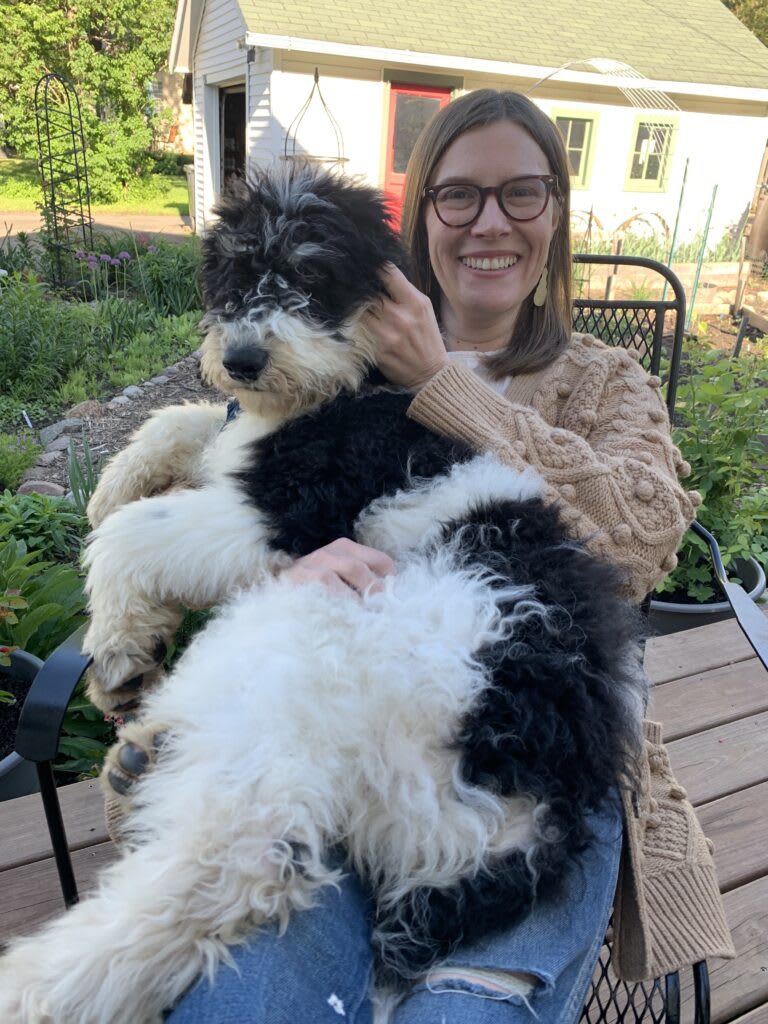Open Philanthropy’s “Day in the Life” series showcases the wide-ranging work of our staff, spotlighting individual team members as they navigate a typical workday. We hope these posts provide an inside look into what working at Open Phil is really like. If you’re interested in joining our team, we encourage you to check out our open roles.
Anna is Open Philanthropy’s Director of Internal Operations. The teams she manages — Recruiting, Immigration, People Operations, Business Operations, and IT — focus on building talent and helping staff do their best work. Before coming to Open Phil, she was Director of Human Resources at Buffalo Exchange, had spent ten years managing teams of 100 to 150 people, worked on political campaigns, and taught reading enrichment.
Anna with her lovely pup, Merlin!
Day in the Life
One of the joys of my day-to-day work is the variety of projects and people I get to support. Across the teams I oversee, my goals are to make sure we set strong priorities, balance trade-offs, hire the right people for the right roles, and ensure that teams have the resources they need. I also serve in cross-functional meetings across Grants, Legal, Finance, and our programmatic work to help us sync on the most critical projects. In any given week, this can feel like a heck of a lot of meetings.
Today is relatively typical. I start by clearing out my email and updating my to-do list. After, I ping a couple of people on Slack and close a few open loops before the day really starts.
My first meeting is with our Immigration and Global Workforce manager, Martin McDonald, who brings incredible expertise to the table. I meet with each of my direct reports weekly for a project check-in — we talk about what’s going well, what’s feeling hard, and the work their team is doing. Open Phil’s emphasis on ownership means that decisions and problem-solving happen at all levels, so I often serve as a thought partner in these meetings. In our call, Martin thinks through different visa vehicles for a Global Catastrophic Risks Capacity Building hire, and his plan for communicating with the applicant and hiring manager. We also have a big win to celebrate — a team member’s visa was approved!
Because I manage a team of managers, I also invest in quarterly “skip-level” meetings with everyone in my reporting line. We think of these meetings as a bit of a “choose your own adventure”, where people are welcome to bring any topic that’s on their mind. Today, I have a few skip-level meetings, one of which is with a relatively senior member of Recruiting. We spend most of our time discussing the path to a more management-focused role.
We’re preparing for our upcoming Togetherness Week, so next up on the agenda is a joint team meeting between Business Operations and People Operations to talk through logistics. Our office space will be accommodating a 5x influx of staff, and members of our globally distributed team will fly in from around the world. As Open Phil grows, each Togetherness Week is our “biggest one yet”. Paying attention to small details helps us continue to run smooth events. In this meeting, the Operations teams are focused on “red teaming” — deliberately stress-testing their plan to anticipate and prepare for what could go wrong.
In addition to developing managers in my reporting line, I also serve as a management coach for leaders at Open Phil and other impact-oriented organizations. My next meeting is one of these coaching sessions, and the conversation is focused on how to build a better feedback culture — including upward feedback — within their team.
I finish my day with a big stack of reading: a few performance reviews and the first draft of a new vendor proposal. I also add some notes to an org-wide email update from IT, as well as to a hiring recommendation for a promising candidate with a tricky onboarding situation. Tomorrow is “No Meeting Wednesday”, which means my calendar is cleared for focus work. I close out my day by lining everything up for my first writing project in the morning.
My work touches many different areas, which is extraordinarily fun and motivating. Each part of my day — working through high-level operational trade-offs, team meetings centered on meeting a specific goal, 1:1 conversations — gives me the chance to see our team’s ownership, resourcefulness, and genuine drive to contribute to our mission from so many different angles.
If you’re excited about operations, come work with me! We’re hiring a Business Operations Manager to help our teams run smoothly (deadline 07/01/2024). If you’d like to work at Open Phil but don’t see the perfect role, you’re also welcome to apply via our General Application.


Executive summary: Anna Weldon, Director of Internal Operations at Open Philanthropy, manages multiple teams and projects to support the organization's mission, emphasizing talent development, efficient operations, and cross-functional collaboration.
Key points:
This comment was auto-generated by the EA Forum Team. Feel free to point out issues with this summary by replying to the comment, and contact us if you have feedback.